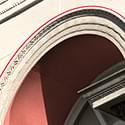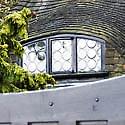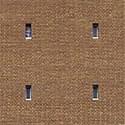
ear, another word for lug, a projection from an architrave.
The illustration shows an eared or lugged architrave of distinctly anthropomorphic character. See also shouldered architrave and lugged architrave. (Photo: Sally Jeffery).
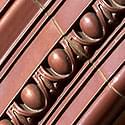
egg–and–dart (or egg–and–tongue), a type of classical ornament consisting of a run of egg–like shapes alternating with dart– or tongue–like forms.
See also under raking moulding.
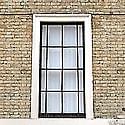
Egyptian window, a window opening with inwardly sloping sides, the top being narrower than the bottom.
Also known as a Tivoli opening from those at the Temple of Vesta at Tivoli, Rome (c.80BC). This is described by Vitruvius in his Ten Books of Architecture and so has come to be known, in addition, as a Vitruvian opening.
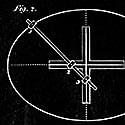
ellipse construction, an illustration of the trammel method of forming a true elliptical figure.
This method was described in Nicholson’s New Carpenter’s Guide . . . Explained, in Theory and Practice by Numerous Engravings, Wherein the Utility of Every Line is Fully Explained . . . on Methods Entirely New (1828). Despite these claims the principle had been known for some time and was already in use when William Halfpenny described it in Sound Building (1725), over a hundred years earlier. Here are Nicholson’s instructions: ‘Fig. 2. To describe an ellipse by a trammel. 1 2 3 is a trammel rod; at 1 is a nut with a hole to hold a pencil in it; at 2 and 3 are two other sliding nuts; make the distance of 2 from 1, half the shortest diameter of your ellipses, and from the nut 1 to 3 equal to half the longest, the points 2 and 3 being put into the groves (grooves) of the same size, then move your pencil round at 1, and the pencil at 1 will describe the true curve of an ellipsis.
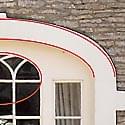
elliptical arch, an arch in the form of a true ellipse.
An elliptical arch is not the same thing as a three–centred or five–centred arch, or even a seven–centred arch. The greater the number of centres, the nearer the arch will approach an ellipse. Mathematically a true ellipse is the intersection of an inclined plane with a cone; this can be constructed in a number of ways in a workshop or on a building site. The most precise method uses a trammel, a combination of simple adjustable timber components that act together to create an ellipse of precisely pre–determined dimensions (see ellipse construction).
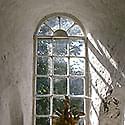
embrasure, the splayed internal sides or reveals of a window opening.
Created for the purpose of allowing more light or a better view, or in the case of military fortifications additionally to create a better line of fire. See also splayed reveal.
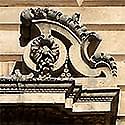
enrichment, ornamentation on or around window architraves or pediments.
These may take the form of mouldings such as egg–and–dart, chaplet, and so on, or as in this case, a cornucopia or enrichments in the true Barocco Luccese style found in Lecce, Southern Italy. See also surround.
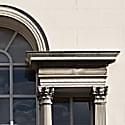
entablature, the collection of horizontal components (cornice, frieze, and architrave) sitting above an opening and acting as a lintel, whether between columns or above a window opening [Italian: tavola, a table, i.e. partaking of the nature of a table].
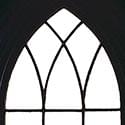
equilateral arch, a pointed two–centred arch in which the radii are equal to the span, each centre being therefore at the springing of the arch.
The springing points and the apex of the arch are therefore the points of an equilateral triangle.
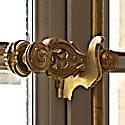
espagnolette (1), a special bolt for locking French windows (casement–doors), traditionally consisting of sliding surface–mounted rods engaging in sockets in the head and threshold of the door frame when operated by a rotating lever handle [French: espagnol, Spanish].
Did this emerge from Spain? In modern versions the rods may be encased within the door stile. This device is known also as the casement–bolt. See also cremorne bolt, a variant on the theme.
eucharistic window, see hagioscope, lychnoscope, low side window.

eye, the central feature in an architectural element, or the opening in the centre of a dome (see also oculus).



